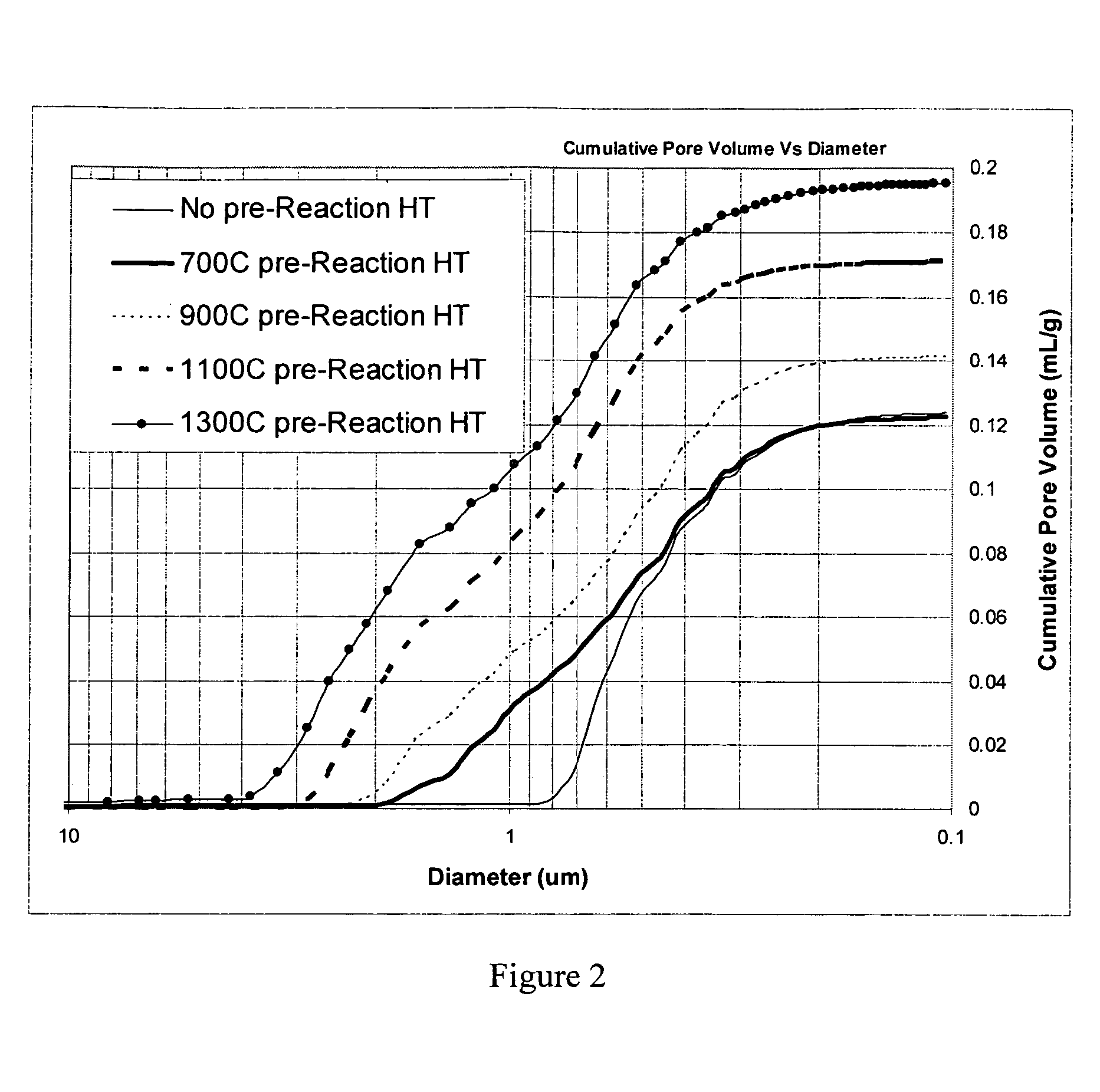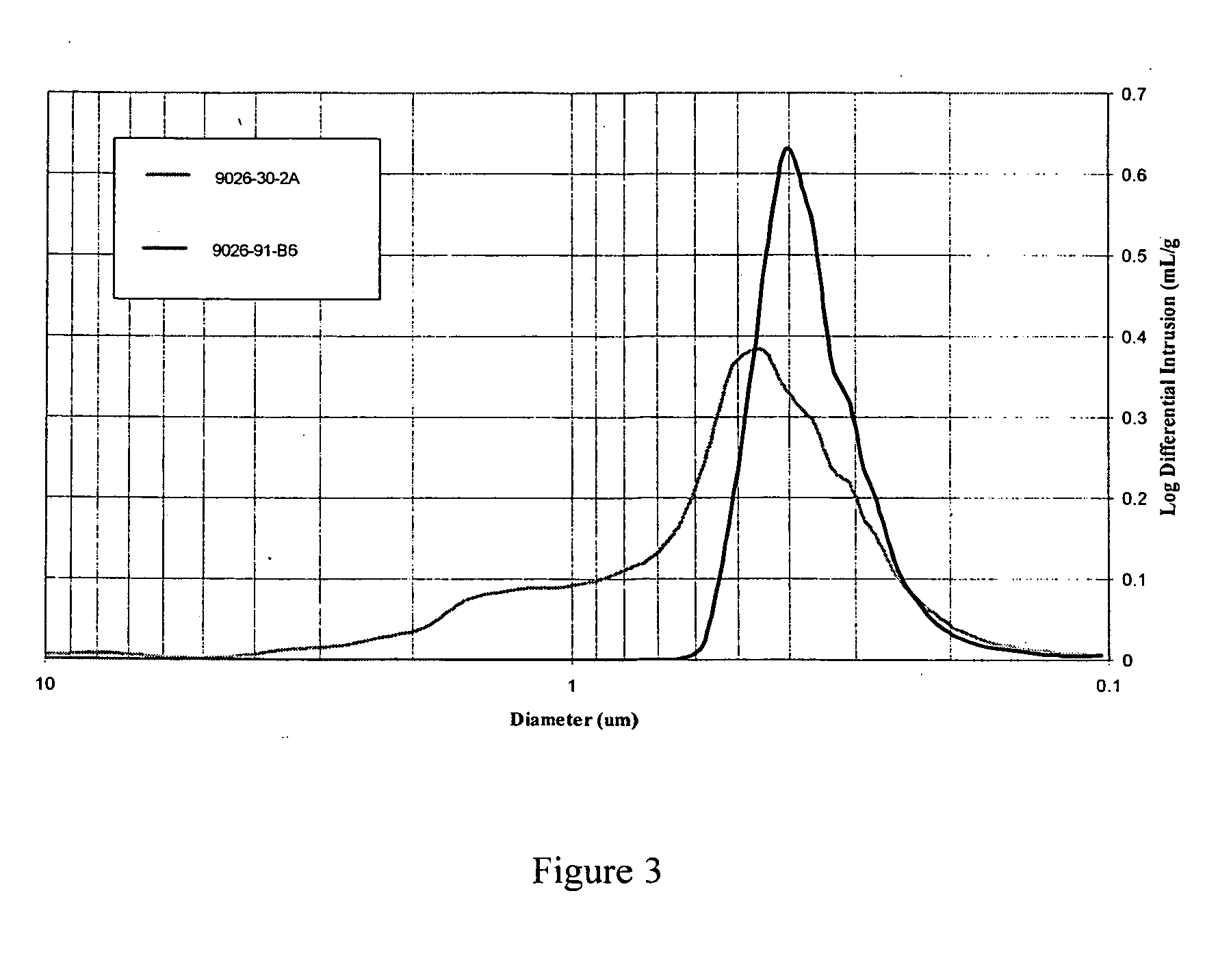Methods of making a niobium metal oxide and oxygen reduced niobium oxides
a technology of which is applied in the field of making niobium metal oxide and oxygen reduction niobium oxides, can solve the problems of low esr, high capacitance (i.e., high volumetric efficiency), and difficulty in working, so as to achieve high esr, low leakage, and high accessible surface area to volume ratio
- Summary
- Abstract
- Description
- Claims
- Application Information
AI Technical Summary
Benefits of technology
Problems solved by technology
Method used
Image
Examples
example 1
According to an embodiment of the invention, niobium powder (200 g) having a BET surface area of 4.1 m2 / g and starting niobium oxide (161 g), i.e., niobium pentoxide, with a BET surface area of 1.3 m2 / g were mixed together to form a powder mixture. The powder mixture was then granulated and screened to a granular size of about −40 mesh. The granular powder mixture was then placed into a vacuum heat treatment furnace and heated under vacuum to about 700° C. for about 2 hours. Hydrogen gas was then admitted to the furnace to a pressure of about 960 Torr. The temperature in the furnace was then brought to about 850° C. and held for about 1 hour. After formation, the oxygen reduced niobium oxide was tested for certain properties which are set forth in Table 1. Three more trials were made with three more sample lots of niobium powder and starting niobium oxide wherein the above described method was repeated with heat treatment temperatures of 900, 1,100, and 1,300° C., respectively. In ...
example 2
According to an embodiment of the invention, niobium hydride powder (20 g) having a BET surface area of 3.9 m2 / g and starting niobium oxide (16.1 g), i.e. niobium pentoxide, with a BET surface area of 3.9 m2 / g were mixed together to form a powder mixture. The powder mixture was then attritor milled (comilled) in water for 2 hours using {fraction (3 / 16)} Nb media. The powder slurry was vacuum dried at 120° C. and granulated by passing the dried powder over a 50 mesh screen. The granular powder mixture was then placed into a vacuum heat treatment furnace and heated to 1100° C. for about 2 hours. The temperature in the furnace was then brought to about 850° C. and hydrogen gas was admitted to the furnace to a pressure of about 960 Torr and held for about 1 hour. After formation, the oxygen reduced niobium oxide was tested for certain properties which are set forth in Table 2. In addition, sample lots of niobium hydride and niobium pentoxide were mixed as described above without the at...
example 3
According to an embodiment of the invention, niobium hydride powder (400 g) having a BET surface area of 3.9 m2 / g and starting niobium oxide (322 g), i.e. niobium pentoxide, with a BET surface area of 3.9 m2 / g were mixed together to form a powder mixture. The powder mixture was then attritor milled (comilled) in water for 2 hours using {fraction (3 / 16)}″ Nb media. The powder slurry was vacuum dried at 120° C. and granulated by passing the dried powder over a 50 mesh screen. In addition, some of the powder was passed over a 70 mesh, 100 mesh and 140 mesh screen. The sample passing through the appropriate screen was collected. The granular powder mixture was then placed into a vacuum heat treatment furnace and heated to 1400° C. for about 2 hours. The temperature in the furnace was then brought to about 850° C. and hydrogen gas was admitted to the furnace to a pressure of about 960 Torr and held for about 1 hour. After formation, the oxygen reduced niobium oxide powders were tested f...
PUM
| Property | Measurement | Unit |
|---|---|---|
| Temperature | aaaaa | aaaaa |
| Temperature | aaaaa | aaaaa |
| Temperature | aaaaa | aaaaa |
Abstract
Description
Claims
Application Information
 Login to View More
Login to View More - R&D
- Intellectual Property
- Life Sciences
- Materials
- Tech Scout
- Unparalleled Data Quality
- Higher Quality Content
- 60% Fewer Hallucinations
Browse by: Latest US Patents, China's latest patents, Technical Efficacy Thesaurus, Application Domain, Technology Topic, Popular Technical Reports.
© 2025 PatSnap. All rights reserved.Legal|Privacy policy|Modern Slavery Act Transparency Statement|Sitemap|About US| Contact US: help@patsnap.com



